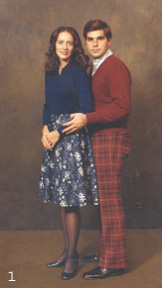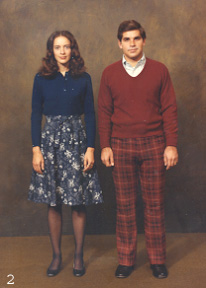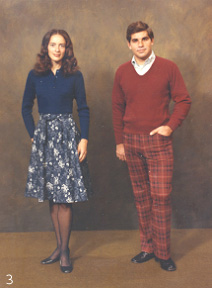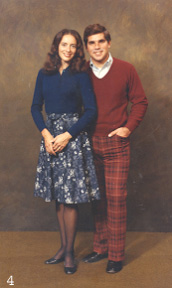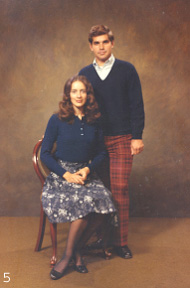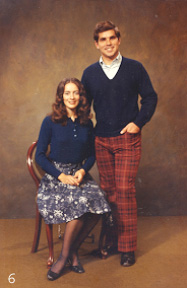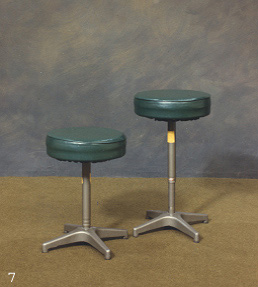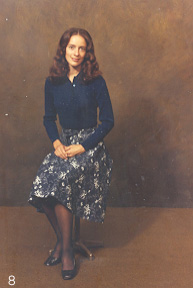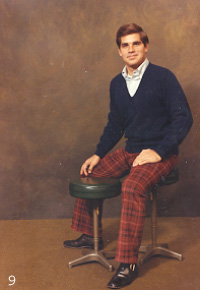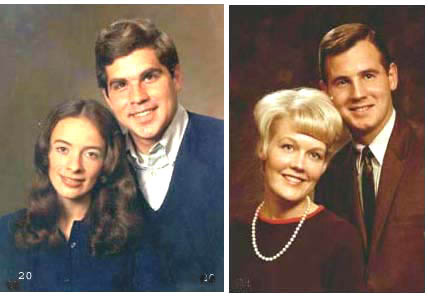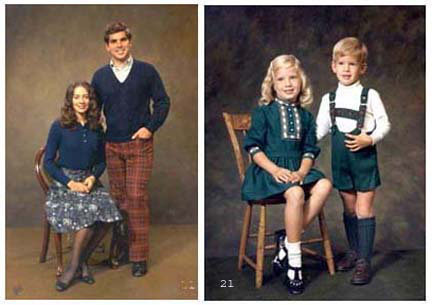|
The Zeltsman Approach to Traditional Classic Portraiture Chapter 11 Posing Couples Introductory comments: The illustrations and instructional commentary of this chapter only show and explain, how to arrange a variety of poses of a Couple, in a traditional classic style. But not how I pose individual figures. You need to know that before starting this chapter. Chapters 4, & 5, Posing Men and chapters 6, & 7, Posing Women provide that information. If you had already gone through them, you understand my arrangement of the figures in either the Masculine or the Feminine composition. Posing a Couple in Full Length I begin by showing this full length arrangement of the couple, below in photo #1. I’m sure you must be familiar with this particular pose, because it seems to be a popular way of arranging couples at school proms, as well as at weddings. The only point of interest in this pose, the couple’s faces, occupy only a small percentage of space in the picture area, and very little seems to be accomplished by showing the subject’s bodies in full length.
Photography, as a communicating medium makes visual statements, and the function of a portrait is to make a meaningful statement about the people we photograph. Here, the statement about this couple, as shown with their bodies turned sideways, tell us nothing about the shape and form of their figures, and turning the subject’s bodies sideways is definitely not the way to pose a couple in full length. Therefore, let’s start over, look at the next two photos, and meet the couple, standing with bodies facing squarely to the front in photo #2 on the left.
You now see the total couple, not just faces, and you can proceed to arrange them by applying the posing guidelines detailed in the Posing Men and Posing Women chapters. Following those posing instructions, you can, in just a few brief moments, transform the two figures in the photo on the left into the elegant arrangements, as shown in the photo on the right, by directing them to position their feet on the floor as shown in this photo, also detailed in the chapters on posing. That automatically turns their bodies in a slight turn to their right, creating a near and a far shoulder. The young lady is now in a pure classic feminine pose, and the young man is in a masculine pose. Also, as detailed in the chapters on posing, you have instant control of the amount of body turn by each of them, by a mere slight turn of the back foot one way or another.
Photo #4 above, shows how the two figures properly posed, are brought together to form this classic full length portrait of the couple. The natural unaffected tilt of the heads toward each other is automatic, when the feminine and the masculine arrangements are brought together in this manner. Indeed, the key to this classic arrangement is that both bodies must be turned in the same direction in exact parallel with each other. This pose can not be arranged when the couple’s bodies are brought together facing each other, as so many photographers seem to be doing. Compare this portrait of the couple with the one in photo #1 on the right. This portrait, in addition to the main point of interest, faces and expressions, also offers a complete view of the couple’s figures, how they relate to each other, and the garments they may be wearing. This classic arrangement is ideal for creating elegant formal full length poses of a Bride and Groom, other couples in the wedding party, school prom couples, or couples at any other dress-up functions where showing the garments is important.
Another full length arrangement of a couple is shown here. The woman is seated while the man remains standing. However, note that in this arrangement their bodies are not parallel. Instead, she is arranged in a classic seated feminine composition facing in towards him, and he stands in a masculine composition facing in toward her. They are arranged that way in both of these photos. But while the photo on the left shows the usual arrangement of the man positioned behind the woman and resting his hand on the back of the chair, the photo on the right shows my somewhat different arrangement of the same pose. I bring the man forward to where both bodies are in the same plane, with his hand now resting on her back, because it is too far for his hand to reach the chair back from his forward position. You have an interesting comparison here. When the man and the woman are posed with their bodies in the same plane, as shown in the photo on the right, both subjects receive equal attention, and the ultimate result is a truly unified portrait of a couple. But when the man is positioned behind the woman, as shown in the photo on the left, she receives more attention, and that seems to create an undesirable feeling that the man is less important. Thus, although the man and the woman are arranged in precisely the same masculine and feminine poses in both photos, my recommended arrangement of placing the bodies in the same plane, as shown on the right, creates the most effective portrait. Posing Couples in Close-up Next, we will discuss my particular approach to arranging couples in a classic close-up pose. And you will see how this one arrangement offers a variety of poses. Next, photo #7, shows two adjustable height posing stools used in arranging that pose.
These stools provide a very convenient means for controlling the relationship between the faces, and their placement in the composition. You will see how these stools are used as we go along.
Beginning an arrangement of a close-up of a couple, the woman is seated first on one of the stools, adjusted to provide her with a comfortable seat height. The second stool is then placed on the side next to her, and the man sits straddling the stool with one leg behind the woman, and the other leg in front. I removed the woman from the stool in the photo on the right, to show how she is actually sitting between his legs. Next photo shows how they are brought together, and we’ll now discuss the step by step details of arranging this pose.
Note the following as you study this illustration in photo #10. The woman is seated in a feminine composition with her body in a very slight turn to her right. She turns her head to the front and tilts the head toward that shoulder. The height of the stool the man is sitting on is adjusted to achieve a desired height relationship between the two faces. A good starting point is to bring his face up to where his mouth will be in an approximate alignment with her eyes, as shown in this photo. When you reach this point in your arrangement, you will find that because his leg is behind her, his body will be turned away too much to his right. At this point you must have him turn the upper part of his body back more toward the front, until his body is exactly parallel with her body, and his face is also turned to the front. Now, you can lean him to bring the two bodies together, as illustrate here. Note how his body lean creates a low far shoulder, and when you complete the masculine composition by placing his head perpendicular to his shoulder line, you automatically achieve the tilt that brings the two heads together, as shown here. Next, photo #11 shows the finished result of this arrangement.
A lovely classic close-up portrait of a couple. The placement of the two faces in this portrait was planned specifically for a horizontal format, as illustrated here. Next, photo #12, shows a very effective variation of the same pose. Here the placement of the faces is changed to fit into a vertical format, simply by raising the stool the man is sitting on a bit higher. As you see, this method of posing with adjustable height posing stools provides complete flexibility for placing faces into any desired height relationship, for either vertical or horizontal arrangements of the classic head and shoulders portraits of couples. Single Arrangement offers Variety of Poses Am interesting and important feature of my particular approach to posing is that, each arranged pose may be photographed from one to five different angles, without changing the original arrangement. Therefore, each completed arrangement offers an instant choice of one to five poses that you can examine, as you step in front of each of the subjects’ five facial views. Obviously, as you appraise the available choices, you will surely photograph only the poses which you deem to be effective, depending on their facial views, etc.. Then, surely each pose you photograph warrants several exposures with changes of expression. All that variety from just a single arranged pose. A reminder: This concept is fully explained and demonstrated in several preceding chapters dealing with posing of Men, Women, and Children. Next photo #13 shows how I dealt with the problem of relating each view I wanted to photograph to the camera.
I introduced this turn platform in previous chapters for arranging head and shoulders poses of men, women, and children. Now, when I place the two posing stools on the turn platform to arrange the couple, I can relate any desired angle of the arrangement to the camera while the pose remains unchanged. The next three photos show the same pose from three different angles, related to the camera by a simple move of the turn platform. The only change was in the repositioning of the key light.
The next two photos are still of the same pose. But the heights of the stool the man is sitting on were adjusted, in the pose on the left slightly higher than on the right, to achieve that difference in the height relationship of the faces, as you can see.
In photo #17 on the left, we again have the classic arrangement showing the two front facial views of the couple in a vertical format. The pose is arranged on the turn platform. And after making several exposures of this basic front view, a quick appraisal of the other four available angles of this pose, disclosed the lovely pose shown here on the right. A simple move of the turn platform related the new pose to the camera, while the actual arrangement remained unchanged. I then repositioned the key light, and made several exposures of the new pose to obtain a variety of expressions. Closing comments: I used this couple as models in this chapter, to show and explain, how to arrange two people together as a "couple", by following my approach to posing people only in masculine and feminine compositions. And to show a particularly unique feature of this method of posing: Every completed arrangement can be photographed from five different angles, allowing a variety of poses from each single arrangement. Note: Most people, I believe, consider the term "couple" to mean Man and Wife, Bride and Groom, Engaged Couple, etc.. Actually however, my posing approach applies when posing any two people together, including women and children. You might find the next three sets of photos interesting. Each set shows on the left how the models were posed. And on the right, exactly the same pose with two different people.. The first set shows a Bride and Groom, posed exactly the same as the models on the left.
The second set also shows the models on the left, and a client couple on the right.
The third set also the models on he left, and the two children in exactly the same pose on the right.
Final note: If you arrange two people in a head and shoulders pose by bringing them together with bodies facing toward each other, that arrangement could not be photographed from any other angle. The option of photographing a head and shoulders pose from five different angles, without changing the arrangement, is available only when the subjects are posed with the bodies parallel facing in the same direction, as explained in this chapter. |
Rehosted on:

